Staff — February 18, 2016

At Colorado State University in Fort Collins, it’s not just the students who are put through the paces. Plants are tested, too, and it’s a rigorous trial that awaits those perennials submitted for evaluation. The university’s W.D. Holley Plant Environmental Research Center (PERC) is home to greenhouses, test gardens and an arboretum—if you haven’t visited, maybe it’s time.
CSU’s perennials trials comprise a continuing study of plants that are placed in a “normal” garden setting— visitors are welcome to roam the grounds during daylight hours— and the best selections each year are tapped for “Top Performer” status. Several that show promise, but are in the middle of the trial period, are deemed “Too Good to Wait.”
Rating the Plants
Plants and flowers in the trials are rated from 0 to 5 on the following scale:
- 0 = Dead/No flowers
- 1 = Poor: Plants are very sick or dying, extremely few flowers
- 2 = Below Average: Plants are unattractive in some form, for example: leggy growth habit; chlorotic or low vigor; flowers are few and occurring sporadically
- 3 = Average: Plant appearance with growth characteristics that would be expected for the time of season; flowers would be few but uniform across the plants
- 4 = Good: Plants look attractive (foliage, growth habit, etc.); flowers are blooming strong and showy
- 5 = Excellent: Plants are very healthy and uniform; flowering is impressive
The Perennial Trial Committee awards Top Performer to plants that have been in the ground for two winters and three growing seasons. The Too Good to Wait category is to acknowledge an upcoming plant that has been in the ground one winter and two growing seasons and has shown excellent performance thus far in the trial.
In 2015, three year-two winter herbaceous perennial trials continued at PERC, and 12 different companies from around the world entered 103 taxa. There were a total of 211 different taxa of herbaceous perennials in the trial. The 2013 entries were evaluated for three years twice a month during the growing season, and photographs were taken at each evaluation. Photographs from all dates were reviewed at the end of 2015 season to determine these “Top Performers.”
2015 CSU “Top Performers”
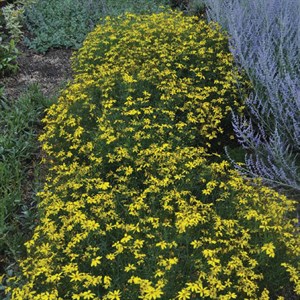
Coreopsis verticillata ‘Mayo Clinic Flower of Hope’ (PPAF) or ‘Electric Avenue’
Coreopsis verticillata ‘Mayo Clinic Flower of Hope’ PPAF, or ‘Electric Avenue’
(Electric Avenue coreopsis; Creek Hill/Eason)
Bright yellow flowers covered the plants over a very long bloom period. Plants were sturdy, compact and uniform from spring to fall. Fine textured foliage and a nice flower shape contributed to a very pleasing overall affect. Overwintering survival was impressive both years compared to many other Coreopsis in trial. This was designated as a winner of the “Too Good To Wait” award in 2014 and did not disappoint in 2015.
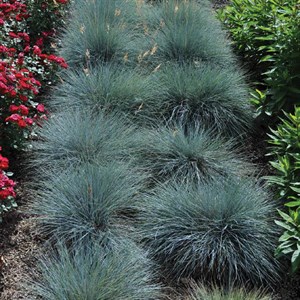
Festuca glauca ‘Casca11’ PP #23307 (Beyond Blue)
Festuca glauca ‘Casca11’ PP #23307
(Beyond Blue fescue; Skagit Gardens)
This fescue was considered to have the best blue color out there! Plants maintained a nice “ball” shape and did not open in the middle, remaining very uniform even after two hard winters and three growing seasons. Flower stems were very few in 2015 and faded into foliage for a superior appearance. This is an improved variety over older ones for foliage color. Beyond Blue was designated as a winner of the “Too Good To Wait” award in 2014 and did not disappoint in 2015.
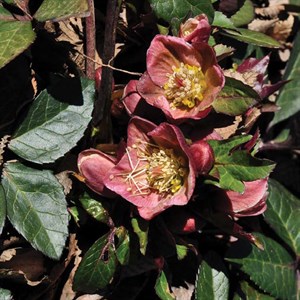
Helleborus × ballardiae ‘COSEH 810’ (USPP #22350 ; Gold Collection® Merlin hellebore)
Helleborus × ballardiae ‘COSEH 810’ USPP #22350
(Gold Collection® Merlin hellebore; Skagit Gardens)
Flowers emerged with a pink color that is brighter than most and then matured to shades of dusty rose. Blooms were held above foliage, creating an impressive display. Plants were more compact, with long-lasting, dark-green foliage; they required very low maintenance.
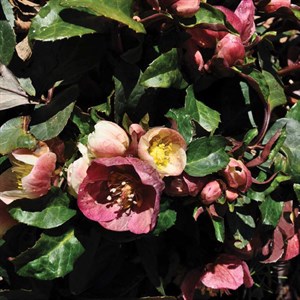
Helleborus × ballardiae ‘COSEH 890’ (Gold Collection® Maestro hellebore}
Helleborus × ballardiae ‘COSEH 890’
(Gold Collection® Maestro hellebore; Skagit Gardens)
Shiny, dark green foliage appeared almost black at times toward the end of the season. Flower petals emerge a deep pink with white and mature to a creamy white with shades of dusty rose on the back side. Flowers covered the plant from side to side and were very prolific. Plants were compact with good vigor.
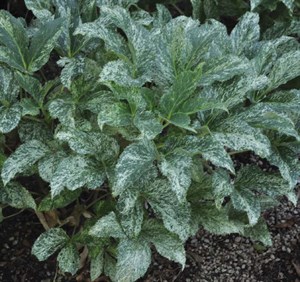
Helleborus × argutifolius ‘COSEH900’ PPAF (Gold Collection® Snow Fever hellebore)
Helleborus × argutifolius ‘COSEH900’ PPAF
(Gold Collection® Snow Fever hellebore; Skagit Gardens)
The speckled green and white variegation makes this a great foliage plant that will add sparkle in shady areas even when not in flower. Sturdy plants have proved hardy over two winters that have been too severe for other variegated varieties of Hellebore.
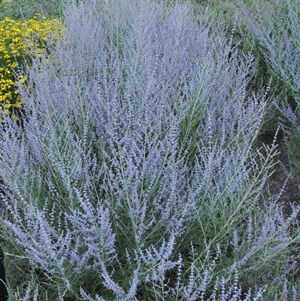
Perovskia ‘Novaperlac’ (Little Lace™ Russian sage)
Perovskia ‘Novaperlac’ (Little Lace™ Russian sage; Star Roses and Plants/The Conard-Pyle Co.)
Growth habit is unique as it combined a shorter plant with great uniformity. Purple flower spikes were long lasting and created a lot of flower power. The tidy, compact plants were a significant improvement over typical sprawling Russian sage in general. It makes a good choice for xeric areas.
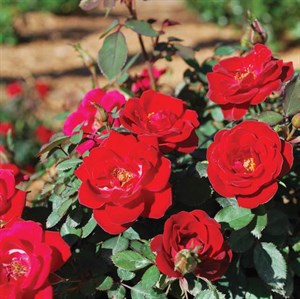
Rosa × hybrid Sunrosa™ Red (Sunrosa™ Red rose)
Photo courtesy of Suntory Flowers Limited
Rosa × hybrid Sunrosa™ Red
(Sunrosa™ Red rose; Suntory® Flowers)
Constant red flowers and impressive growth habit made this plant attractive all season. Glossy dark green foliage had no signs of chlorosis or disease. Red flowers did not fade and bloomed steadily from mid-June through October. Small foliage and a dwarf compact growth habit made this a good choice for smaller or mid-size landscapes. The compact growth habit is maintained without any pruning. This was designated as a winner of the “Too Good To Wait” award in 2014 and did not disappoint in 2015 either.
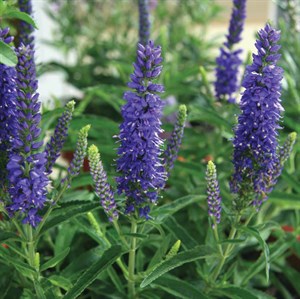
Veronica ‘Novaverblu’ (Dark Blue Moody Blues™ veronica)
Photo courtesy of Star Roses and Plants
Veronica ‘Novaverblu’
(Dark Blue Moody Blues™ veronica; Star Roses and Plants/The Conard-Pyle Co.)
Long bloom period and the abundant spikes of dark blue flowers made this a standout. Plants were very uniform and had excellent winter hardiness. Additionally, plants had good resistance to disease and there was no sign of powdery mildew. The entire Moody Blues™ series was noted for superior performance.
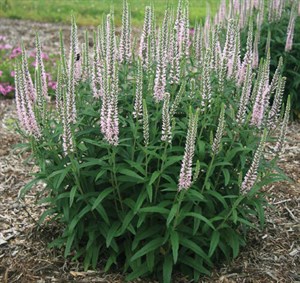
Veronica ‘Novaverpin’ (Pink Moody Blues™ veronica)
Photo courtesy of Star Roses and Plants
Veronica ‘Novaverpin’
(Pink Moody Blues™ veronica; Star Roses and Plants/The Conard-Pyle Co.)
Flowers were noted for having exceptionally uniform, perfect spikes of light pink flowers that helped create an impressive overall display. Growth habit and flowering were very uniform. The overall height was taller than others in the Moody Blues™ series but still maintained a nice, compact habit. The entire Moody Blues™ series was noted for superior performance.
Class of 2014 “Too Good to Wait”
The following two plants impressed the Perennial Trial Committee so much that they designated the category name: “Too Good to Wait Performer.”
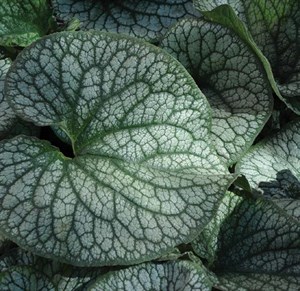
Brunnera macrophylla ‘Alexanders Great’
Brunnera macrophylla ‘Alexanders Great’ PP25,789
(Alexanders Great brunnera; Terra Nova Nurseries Inc.)
This is a unique brunnera of “monster” growth proportions, which is an excellent choice to add structure to the garden. The large size also helped show off the heavily silvered leaves resulting in a dramatic statement for the garden. It makes a great foliage plant for shady areas but also had a good display of blue flowers that created a light, airy appearance.
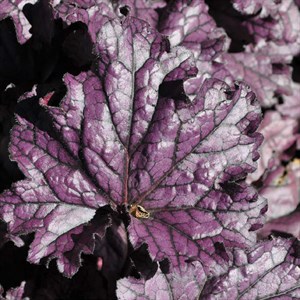
Heuchera ‘Forever Purple’ PPAF (Forever Purple coral bells)
Heuchera ‘Forever Purple’ PPAF
(Forever Purple coral bells; Terra Nova Nurseries Inc.)
Leaves had an intense purple color with a shade of red that was maintained all season. The glossy foliage seemed to make the color “bounce” off the leaf. It is grown mostly for attractive foliage, which also has fluted edges. Plants had good vigor and a uniform growth habit.
For more information about the Colorado State University trials program, visit http://www.flowertrials.colostate.edu/trial_garden.php?category=Perennial. The trial program is supervised by James Klett, Director of PERC and Professor and Extension landscape horticulture specialist in the Department of Horticulture and Landscape Architecture at Colorado State University in Fort Collins—where he’s worked at perfecting plants for 35 years. He can be reached at [email protected].
Photos courtesy of Colorado State University, unless otherwise noted.